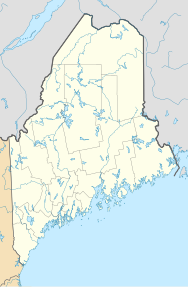Fairfield, Maine
| Fairfield, Maine | |
|---|---|
| Town | |

Main Street in 1910
|
|
| Location within the state of Maine | |
| Coordinates: 44°37′20″N 69°37′58″W / 44.62222°N 69.63278°W | |
| Country | United States |
| State | Maine |
| County | Somerset |
| Incorporated | 1788 |
| Area | |
| • Total | 54.58 sq mi (141.36 km2) |
| • Land | 53.75 sq mi (139.21 km2) |
| • Water | 0.83 sq mi (2.15 km2) |
| Elevation | 207 ft (63 m) |
| Population (2010) | |
| • Total | 6,735 |
| • Estimate (2012) | 6,675 |
| • Density | 125.3/sq mi (48.4/km2) |
| Time zone | Eastern (EST) (UTC-5) |
| • Summer (DST) | EDT (UTC-4) |
| ZIP code | 04937 |
| Area code(s) | 207 |
| FIPS code | 23-24320 |
| GNIS feature ID | 0582471 |
| Website | fairfieldme.com/town |
Fairfield is a town in Somerset County, Maine, United States. The population was 6,735 at the 2010 census. The town includes Fairfield Center, Fairfield village and Hinckley, and borders the city of Waterville to the south. It is home to the Good Will-Hinckley School, Lawrence High School and Kennebec Valley Community College.
The area was territory of the Canibas tribe of Abenaki Indians residing at Taconnet village, once located downriver at the confluence of the Sebasticook and Kennebec rivers in what is today Winslow. In 1692 during King William's War, the village was burned, so the Canibas tribe abandoned the area. The French and Indian Wars finally ended in 1763, leaving the region open for English colonization. Fairfield Plantation, named for its fair aspect, was first settled in 1774.
Benedict Arnold and his troops rested and re-provisioned here in 1775 during their march up the Kennebec River to the Battle of Quebec. Following the Revolutionary War, Fairfield Plantation developed as a trade and agricultural town, with farms producing hay, grain and potatoes. It was noted for the number and quality of its cattle. On June 18, 1788, it was incorporated as Fairfield. By 1790, the community had 492 inhabitants. In 1837, it produced 11,531 bushels of wheat and a large quantity of wool.
Falls on the Kennebec drop 34 feet (10 m) at Fairfield, providing water power for industry. The mill town had eight sawmills, three planing mills, a gristmill, a canned corn factory, plaster mill, three carriage factories, a sled factory, two door, sash and blind factories, a cabinet and box factory, coffin factory, a clothing factory, a marble works and a tannery. The largest factories were the textile plants—Kendall's Mills in the southeastern extremity of the town, and Somerset Mills located about two miles above.
...
Wikipedia

